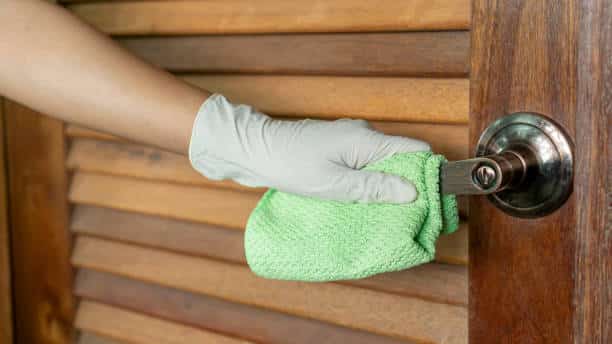Locks play a crucial role in keeping our homes and belongings safe. Over time, however, locks can accumulate dirt, debris, and rust, causing them to become sticky or difficult to operate. Regular cleaning and maintenance can greatly improve the performance and longevity of your lock. In this comprehensive guide, we will walk you through the step-by-step process of how to clean a lock effectively, ensuring that it functions smoothly and remains in optimal condition for years to come.
Why should you clean your lock?
Cleaning your lock regularly is essential for several reasons. First and foremost, it ensures that the lock operates smoothly, making it easier to open and close. A clean lock is less likely to get stuck, preventing frustrating situations where you struggle to unlock your door. Moreover, regular cleaning removes dirt and debris that can accumulate inside the lock mechanism, reducing the risk of damage and extending the lock’s lifespan. By investing a little time and effort into cleaning your lock, you can save yourself from the inconvenience and expense of having to replace it in the future.
Tools and materials needed for lock cleaning
Before we dive into the cleaning process, let’s gather the necessary tools and materials. You will need:
- Screwdriver set: To disassemble the lock, you will need a screwdriver set with various sizes and types of heads.
- Cleaning solution: There are two main options for lock cleaning solutions – homemade and commercial. Homemade solutions often include a mixture of vinegar and water, while commercial options can be purchased from hardware stores.
- Cotton swabs: These are useful for reaching small and intricate parts of the lock.
- Toothbrush: An old toothbrush can be used to scrub away dirt and grime from the lock components.
- Lubricant: After cleaning, you will need a lock lubricant to ensure smooth operation. Graphite or silicone-based lubricants are commonly recommended for locks.
Now that we have the necessary tools and materials, let’s begin the lock cleaning process.
Step 1: Preparation and safety precautions
Before starting the cleaning process, it’s important to take some precautions to ensure your safety and the security of your property. Begin by gathering all the tools and materials in one place, so you have everything you need within reach. Additionally, make sure you have a clean and well-lit workspace, preferably near a sink, as the cleaning process can get messy.
It’s also crucial to consider safety measures. If you’re working on an exterior door, make sure to lock it from the inside to prevent anyone from accidentally opening it while you’re cleaning. If you’re cleaning a lock on an interior door, ensure that the door is closed and latched to avoid any disturbance during the cleaning process.
Step 2: Removing the lock from the door
To clean a lock thoroughly, it’s best to remove it from the door. Start by locating the mounting screws on the interior side of the door. Using the appropriate screwdriver, carefully unscrew the mounting screws and set them aside in a safe place. Once the screws are removed, you should be able to pull the lock out of the door. Be gentle and avoid using excessive force to prevent any damage to the lock or door.
Step 3: Disassembling the lock
With the lock removed from the door, it’s time to disassemble it to access all the components that need cleaning. Most locks consist of a faceplate, cylinder, latch, and other smaller parts. Refer to the lock manufacturer’s instructions if you’re unsure about the disassembly process. Using the appropriate screwdriver, remove the screws holding the lock components together. As you disassemble the lock, it’s helpful to take pictures or make notes to ensure you can easily reassemble it later.
Now that we have disassembled the lock, let’s move on to the next step – cleaning the lock components.
Step 4: Cleaning the lock components
Cleaning the lock components is a crucial step in the process, as it removes dirt, debris, and rust that can hinder the lock’s performance. Begin by inspecting each component individually. Use a toothbrush or cotton swab to gently scrub away any visible dirt or grime. Pay close attention to hard-to-reach areas, such as the crevices between the faceplate and cylinder. If you encounter stubborn dirt or rust, you can soak the components in a cleaning solution for a few minutes to help loosen the debris.
Once all the lock components are cleaned, rinse them thoroughly with water to remove any residual cleaning solution. Use a cloth or paper towel to dry each component before moving on to the next step.
Step 5: Applying lock cleaning solution
In this step, we will apply a lock cleaning solution to further enhance the cleanliness and performance of the lock. As mentioned earlier, there are two options for lock cleaning solutions – homemade and commercial. Let’s explore both options:
Homemade lock cleaning solution
To create a homemade lock cleaning solution, mix equal parts of vinegar and water in a small bowl or container. Vinegar is a natural cleaning agent that helps dissolve dirt and grime. Dip a cotton swab or toothbrush into the solution and gently scrub each cleaned lock component. Be careful not to oversaturate the components with the solution, as excess liquid can seep into sensitive areas and cause damage. Once you have thoroughly cleaned all the components, rinse them with water and dry them completely.
Commercial lock cleaning solution
If you prefer a commercial lock cleaning solution, visit your local hardware store and look for a product specifically designed for cleaning locks. These solutions often come in spray bottles or aerosol cans for easy application. For safe and efficient use, follow the directions on the packaging. Apply the solution to each cleaned lock component, following the manufacturer’s guidelines. Remember to rinse the components with water and dry them thoroughly afterward.
Step 6: Reassembling the lock
With the lock components cleaned and dried, it’s time to reassemble the lock. Begin by referring to the pictures or notes you took during the disassembly process to ensure you put the components back together correctly. Start with the cylinder and insert it into the lock body. Align the screw holes and use the appropriate screws to secure the cylinder in place. Repeat this process for each component until the lock is fully reassembled.
Take your time during this step to ensure that each component is properly aligned and securely fastened. A well-assembled lock will operate smoothly and provide optimal security.
Step 7: Lubricating the lock
After reassembling the lock, it’s important to lubricate it to ensure smooth operation. Lock lubricants reduce friction between the moving parts, preventing wear and tear and prolonging the lock’s lifespan. There are two common types of lock lubricants – graphite and silicone-based lubricants. Let’s explore each option:
Graphite lubricant
Graphite lubricant is a dry lubricant that comes in powder or liquid form. It is specifically designed for locks and provides excellent long-lasting lubrication. To apply graphite lubricant, insert the key into the lock and turn it several times to distribute the lubricant evenly. Be cautious not to oversaturate the lock with graphite, as excess powder can create a mess. Wipe away any excess graphite with a cloth or paper towel.
Silicone-based lubricant
Silicone-based lubricants are versatile and can be used for various household applications, including locks. They provide long-lasting lubrication and protection against rust and corrosion. Apply a small amount of silicone-based lubricant to the key and insert it into the lock. Turn the key back and forth to distribute the lubricant throughout the lock. Similar to graphite lubricant, wipe away any excess lubricant to prevent buildup.
Step 8: Testing the lock’s performance
With the lock cleaned, reassembled, and lubricated, it’s time to test its performance. Insert the key into the lock and turn it to ensure smooth and easy operation. The key should glide effortlessly, and the lock should engage and disengage without any resistance. Test the lock multiple times to ensure consistent performance. If you notice any issues, such as sticking or difficulty turning the key, double-check the assembly and lubrication. If the problem persists, it may be necessary to consult a professional locksmith.
Lock cleaning solutions: Homemade vs. commercial options
When it comes to lock cleaning solutions, you have the choice between homemade and commercial options. Both options have their merits, so let’s weigh the pros and cons:
Homemade lock cleaning solution
Pros:
- Cost-effective: Homemade solutions often use common household ingredients, making them more affordable than commercial options.
- Natural ingredients: Homemade solutions typically use natural ingredients such as vinegar, which are less harsh and environmentally friendly.
- DIY satisfaction: Creating your cleaning solution can be a rewarding experience, and you have control over the ingredients used.
Cons:
- Effectiveness may vary: Homemade solutions may not be as effective as commercial products, especially for stubborn dirt and grime.
- Limited shelf life: Homemade solutions may not have a long shelf life compared to commercial products, as they lack preservatives.
Commercial lock cleaning solution
Pros:
- High effectiveness: Commercial lock cleaning solutions are specifically formulated to remove dirt, grime, and rust from locks, ensuring optimal performance.
- Convenience: Commercial products are readily available in hardware stores, saving you time and effort in preparing a homemade solution.
- Long-lasting: Commercial products often have a longer shelf life and can be stored for future use.
Cons:
- Cost: Commercial lock cleaning solutions can be more expensive than homemade options, especially if you need to clean multiple locks.
- Harsh chemicals: Some commercial products may contain harsh chemicals that require caution during use. Pay close attention to the directions and read the product labels.
Ultimately, the choice between homemade and commercial lock cleaning solutions depends on your preferences, budget, and the level of cleaning required.
Tips for maintaining a clean lock
Once you have cleaned and maintained your lock, it’s important to adopt good practices to keep it clean and functioning smoothly. Here are some tips to help you maintain a clean lock:
- Regular cleaning: Set a schedule for regular lock cleaning, especially if you live in a dusty or humid environment. This will prevent the accumulation of dirt and grime.
- Avoid excessive lubrication: While lubrication is important for a lock’s performance, using too much lubricant can attract dirt and debris. Apply a small amount of lubricant and wipe away any excess.
- Keep the surroundings clean: Dust and debris can find their way into your lock, affecting its performance. Regularly clean the area around the lock to minimize the chances of dirt getting inside.
- Avoid using excessive force: Forcing a key into a lock can damage the lock mechanism and make it more difficult to clean and repair. Insert the key gently and turn it in a smooth motion.
- Seek professional help when needed: If you encounter persistent issues with your lock or are unsure about the cleaning process, it’s best to consult a professional locksmith. They have the expertise to diagnose and solve lock-related problems.
By following these tips, you can maintain a clean and well-functioning lock, ensuring the security and convenience of your home.
Common mistakes to avoid when cleaning a lock
While cleaning a lock is a relatively straightforward process, there are a few common mistakes that you should avoid:
- Using the wrong tools: Ensure that you have the correct type and size of screwdrivers to avoid damaging the lock screws or components.
- Rushing the disassembly process: Take your time when disassembling the lock and make sure to document the process. Rushing can lead to misplaced or lost components, making reassembly challenging.
- Using excessive force: Be gentle when removing the lock from the door and disassembling the components. Excessive force can cause damage and make the cleaning process more difficult.
- Neglecting to dry the components: After cleaning, it’s essential to dry each component thoroughly before reassembling the lock. Moisture can lead to rust and corrosion, affecting the lock’s performance.
- Over-lubricating the lock: While lubrication is important, using too much lubricant can attract dirt and debris, causing the lock to become sticky or difficult to operate. Apply a small amount of lubricant and wipe away any excess.
By avoiding these common mistakes, you can ensure a smooth and successful lock cleaning process.
Conclusion
Regular cleaning and maintenance are essential for keeping your locks in optimal condition. By following this step-by-step guide, you can clean your lock effectively, improving its performance and longevity. From preparing the necessary tools and materials to disassembling and cleaning the lock components, each step is crucial for achieving a clean and well-functioning lock. Whether you choose a homemade or commercial lock cleaning solution, ensure that you follow the instructions carefully and take the necessary safety precautions. By adopting good maintenance practices and avoiding common mistakes, you can enjoy the convenience and security of a clean and well-maintained lock for years to come.
Frequently Asked Questions
1. Can I use any cleaning solution to clean my locks?
It’s best to avoid using harsh cleaning chemicals or solvents on your locks, as they can cause damage. Stick to mild soap and water or dedicated lock cleaning solutions that are safe for use.
2. How often should I clean my locks?
The frequency of lock cleaning depends on various factors such as the environment, usage, and exposure to dirt and dust. As a general rule, aim to clean your locks at least once every six months.
3. Can I use WD-40 as a lock lubricant?
While WD-40 can help to temporarily lubricate a lock, it is not recommended for long-term use. It is best to use a lock lubricant specifically designed for locks.
4. Is it necessary to remove the lock from its housing to clean it?
Removing the lock from its housing allows for a more thorough cleaning. However, if you’re unsure or uncomfortable with removing the lock, you can still clean the exterior and interior to some extent without removing it.
5. Can I use graphite powder instead of a lock lubricant?
Graphite powder can be used as an alternative to lock lubricant, particularly for keyways. However, it is best to consult the lock manufacturer’s recommendations to ensure compatibility and effectiveness.


